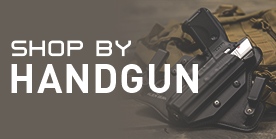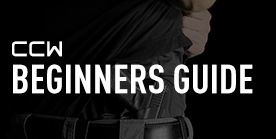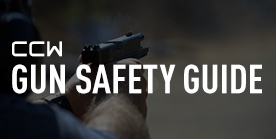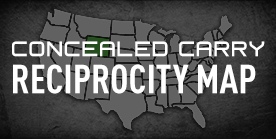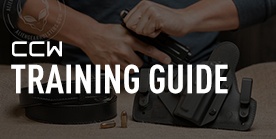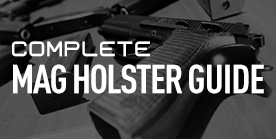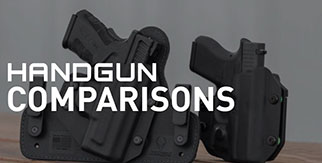
What To Know About Picking A CCW Pistol
Choosing a concealed carry pistol is not necessarily the easiest thing to do. There are a number of factors to consider, including the "on paper" specifications as well as the intangibles that a magazine or internet article can't tell you.
Another thing to bear in mind is that there's no such thing as a perfect carry gun - but there may be a right gun for you. Here are a few of the things you should look at.
Picking The Right Gun Size

When it comes to concealed carry, one of the biggest factors to consider is gun size, in all three dimensions, as it makes a considerable impact. Generally speaking, there are four classes of pistol size, though plenty of guns flirt with other categories.
Full-size pistols are the most common size of firearm. Full-size guns generally have an overall height of 5 or more inches, barrel length of 4 or more inches, overall length of 7 inches or more and width of at least 1 inch or more. Capacity in these pistols is often higher, as some full-size pistols carry close to 20 rounds, and magazines are usually double-stack, meaning two staggered rows of bullets are held in the magazine...though not all.
These guns are the easiest to shoot, but weigh more and can be more difficult to conceal. Popular full-size pistols include the Beretta 92, Sig Sauer P226, Smith and Wesson K-frame pistols with 4-inch (or longer) barrels, the CZ-75, the Glock 17, the Ruger American and the "Government frame" 1911 pistol platform.
Compact pistols are slightly smaller than full-size guns. Usually, barrel lengths are 3 to 4 inches, overall length is 7.5 inches or less and overall height is between 4.5 and 5 inches. Width is usually the same as full-size pistols. Double-stack magazines are very common. These pistols are somewhat more easily concealed and carried, though some find them still difficult in this regard. This class of pistol is still quite easy to shoot in most calibers, and many find them to be something of a "Goldilocks" gun - small enough to conceal and carry, big enough to shoot very well.
Often enough, these pistols are created by shortening the barrel, slide and frame length and height of a full-size pistol. Capacity in compact pistols is often, but not always, the same or slightly reduced compared to full-size pistols, though some compact pistols may accept full-size magazines. Examples such as the CZ-75 Compact, Beretta PX4 Compact and Glock 19 essentially fit the same pattern. Compact revolvers are typically have a 3-inch or shorter barrel, and many reduce capacity to 5 shots for .38 Special or .357 Magnum chamberings.
Sub-compact pistols are basically the halfway point between a compact and a pocket pistol. Barrel length is often 3 inches or less, overall length is closer to 6 inches and overall height is usually less than 5 inches. Single-stack magazines become much more prevalent in this class of firearm, though some sub-compact pistols do employ a double-stack magazine.
Popular sub-compact guns include the Glock 26, CZ-75 RAMI, Sig Sauer P290, P938 and P239, Smith and Wesson M&P Shield, Ruger LC family of pistols (LCP, LC9, LC9s), Springfield EMP 1911, Bersa Thunder .380 and many others. Subcompact revolvers are the small-frame "snubnose" revolvers, such as the Smith and Wesson J-frame, Charter Arms Undercover, Ruger LCR and others. This class of firearm can be somewhat more difficult to shoot for extended periods, but some are known for being easier than others.
Micro-pistols are the smallest possible pistols for carry, often small enough to fit easily in a pocket. Smaller calibers such as .25 ACP, .32 ACP, and in particular the .380 Auto, dominate in this class of pistol. Guns such as the Kel Tec P32 and P3AT, S&W Bodyguard .380, Beretta Pico and Tomcat, Sig Sauer P238, Colt Mustang and others are among the more popular examples.
Micro-pistols are often thought of as a "last ditch gun" and many carry them only when the deepest of concealment is needed or as a backup. Many shooters find the best micro pistols are "bearable" to shoot and little more, as the small size dictates the shooter bear the brunt of the recoil, which can be ample despite a small caliber.
What To Look For In A CCW Pistol

In choosing the right size of gun as a CCW pistol, there are certain considerations to make.
First - can I shoot this pistol well? Full-size firearms, especially large double-stack service guns, can fill even large hands. Some shooters find them too large for comfort. Additionally, you won't shoot a gun well if you can't get a good, comfortable grip. By contrast, some people can barely hit the broadside of a barn with a micro-pistol at even close range.
Second, how much gun are you willing to carry on a regular basis? A fully-loaded firearm can add 3 or more pounds to the beltline. People with a larger frame can carry a full-size firearm without much complaint, but smaller persons (male or female) may find a subcompact is much more to their liking. Some people don't want to carry anything more than a J-frame or other snub-nose revolver.
Third, make sure that you can easily operate a pistol. If the firing mechanism is too complicated for you to easily use, then it may not be the gun for you. Do you need or want to have a manual safety or multiple safety mechanisms? You should learn about how guns operate, and decide what features you want in a pistol.
Lastly, consider how you're going to carry. Inside-the-waistband carry is the gold standard for concealed carry, but a full-size pistol can be uncomfortable compared a slim, single-stack subcompact. OWB carry makes concealment more problematic - though there are OWB holsters out there that can be concealed with as little as a t-shirt - but does make carrying a larger pistol easier.
Try Different Guns Before You Buy A Gun For Carry

Before you commit to a buying a gun for concealed carry, you should try as many of them as possible including shooting them. The good news is this may be easily done.
A good number of gun stores have indoor ranges and rentals available. This will allow you to try various types of pistols, including the various gun sizes, calibers and firing mechanisms. This way, you can get a feel for what you're able to shoot well. Some outdoor ranges have rentals available as well.
The rule of thumb is you should carry the smallest gun with the largest caliber that you can shoot well. If that's a single-stack 9mm subcompact, that's fine. If that's a mid-size .45 ACP such as a Smith & Wesson M&P45C or any brand of Commander 1911, that's fine too. If you're best with a 3-inch .38 Special, that's just fine as well. Once you've begun carrying, you'll want to put in regular practice to keep shooting skills sharp. Therefore, you'll need to carry a pistol you can stand to practice with.
If possible, try both practice ammunition - full metal jacket - and defensive ammunition - jacketed hollow point or semi-wadcutter - in a potential carry gun. This will give you a feel of how well you shoot the kind of ammunition you'll want to carry daily.
Another good consideration is not to spend more than you're willing to lose. The potential aftermath of a defensive shooting is that you may have your gun confiscated by police as evidence...which you may not get back in working condition, even if said shooting is ruled wholly justified.
These aren't the only considerations to make when choosing a CCW gun, but if you follow these guidelines...you should find the right gun for you.
 |
About The Author Born in southeastern Washington State, Sam Hoober graduated in 2011 from Eastern Washington University. He resides in the great Inland Northwest, with his wife and child. His varied interests and hobbies include camping, fishing, hunting, and spending time at the gun range as often as possible. |


